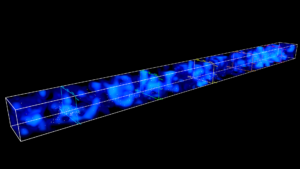About the CLAMATO Project
The COSMOS Lyman-Alpha Mapping And Tomography Observations (CLAMATO) survey aims to map the cosmic web at z=2.3, at over 11 billion light years away when the Universe was less than a quarter its current age, using the LRIS spectrograph on the Keck-I telescope at Maunakea, Hawai’i. We create a map using Lyα forest tomography, which expands upon the HI Lyα forest analysis of IGM absorption that is traditionally carried out along relatively sparse quasar lines-of-sight (e.g. the BOSS Lyα forest sample). We target ubiquitous star-forming Lyman-Break galaxies (LBGs) and faint quasars at z ∼ 2 − 3 as background sources at a much higher source density than surveys such as BOSS. The small separation between sources allows us to tomographically interpolate across the adjacent lines-of-sight to create 3D maps of the IGM HI absorption, a nonlinear tracer of the underlying dark matter cosmic web. The resulting maps will enable the first analysis of the relationship between galaxy properties and the cosmic web at z=2.3. Similar studies have previously been restricted to z ≤ 0.6, where sufficiently high-density galaxy samples exist to trace the cosmic web. CLAMATO will provide the first analysis of the relationship between galaxies and their environment at the epoch of peak star formation.
For a more layperson-friendly explanation, check out some of our previous press releases.

CLAMATO 2017 tomographic map of the 2.05<z<2.55 intergalactic medium in the COSMOS field. See YouTube for 360 video version of the map.
Due to the long (∼ 400 h−1 Mpc) path length in the Lyα forest probed by each background source, Lyα forest tomography allows us to map large volumes at z > 2. CLAMATO will make the first characterization of sheets and filaments in the high-redshift cosmic web and carry out a volume-limited search for voids and protoclusters. Additionally, we can use the local IGM absorption as a proxy for the local dark matter density (and thus halo mass) of individual galaxies within the map volume.CLAMATO aims to eventually cover the central 0.5-0.8 deg2 of the COSMOS field.